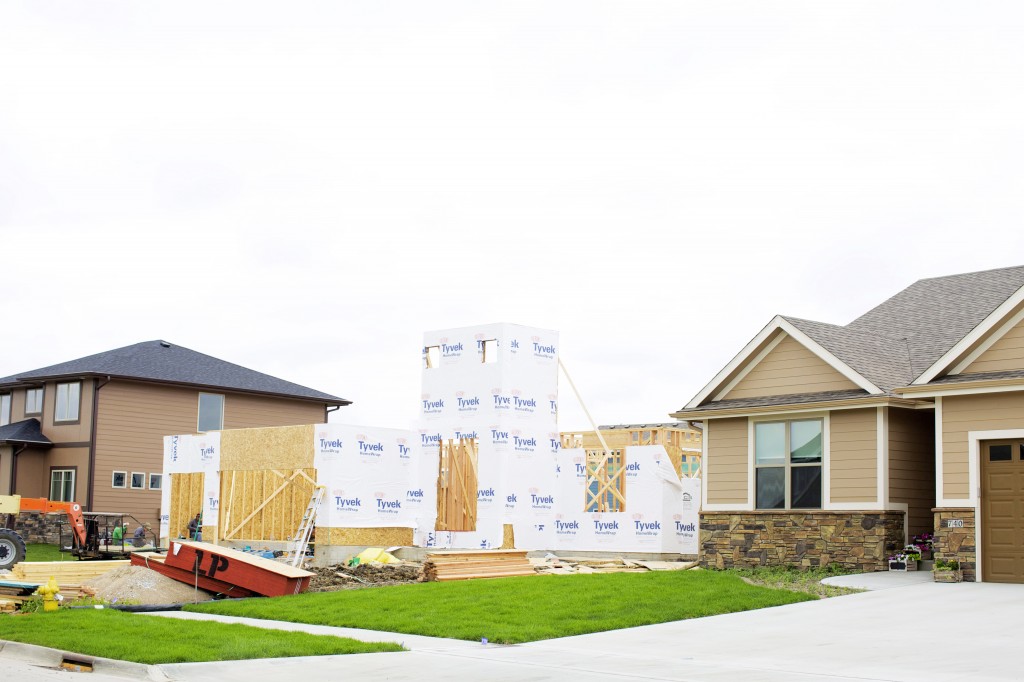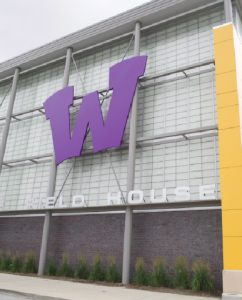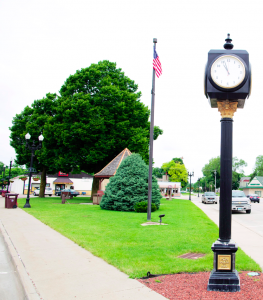
Photography by Laura Wills
The growth of Waukee—dubbed the fastest-growing city in Iowa—has fascinated outsiders and thrilled its residents. According to the U.S. Census Bureau, the city’s population stood at about 13,800 people in 2010 and grew to 17,077 in 2013—an increase of 22 percent. With housing and commercial developments in the works, Waukee is poised to continue its rapid growth in both residential population and economic growth. Despite the challenges presented by fast expansion, the city has managed to maintain its small-town feel and family-friendly aesthetic, while providing services to citizens.
Three city leaders recently shared their insights on the reasons for the city’s growth and its future direction.
“Any forecast we’ve put out, the population growth has always blown it away,” said Rick Peterson, city councilman. Peterson is a six-year resident of the city. When he and his family made their home here, it was “still kind of country” but growing quickly.
Dan Dutcher is the Community and Economic Development Director for the city and a 23-year resident. Dutcher and his family moved here because of the educational opportunities, although the shape of the school district was much different at the time.
As the Development Services Director, Brad Deets has worked for the city for nine years and is a three-year resident. He’s in charge of the long-term planning for the city, which includes the development review process. “When I came to Waukee, we were right around 8,000 people,” said Deets. “We’ve more than doubled since then.”
Top-Notch School District
There are a number of reasons for the growth of Waukee, but all three leaders agree the school district is the main component. “It’s a big drive for the residents that come here,” said Peterson. As a parent of two kids, Peterson feels it’s the high caliber of teachers and the curriculum they deliver that sets the school district apart.
 Deets agrees. “Our school district is second to none in the Des Moines area as far as the instruction provided, and that generates interest from young families who want to move to our community,” he said.
Deets agrees. “Our school district is second to none in the Des Moines area as far as the instruction provided, and that generates interest from young families who want to move to our community,” he said.
Waukee’s school district is known for its innovative approach to education, and with the new Center for Advanced Professional Studies (CAPS) program, students have even more opportunities to prepare themselves for a bright future. “The program is designed for high school students, and it opens up a number of incredible opportunities for them to participate in professional studies. They learn with a diverse group of people from academia, the business world, and the community,” said Peterson.
The CAPS program began in 2014 and enrolled 120 students. After the completion of the program’s stand-alone facility in 2016, the program will have room for upwards of 500 students. Students get real world experience through collaboration with community business partners. Inquiry-based learning, combined with hands-on projects and experiences, allow students to explore career possibilities in finance and insurance, technology, engineering, human services, and bioscience and value-added agriculture. Students have the chance to earn college credits or certifications while earning high school credit.
Location, Location, Location
Waukee’s location is also attractive to many. The western suburbs of Des Moines have seen a lot of growth in the last few years. As sites and homes have been filled and sold in West Des Moines and Urbandale, growth and development has moved further west. “The nice thing about Waukee is that we’ve been able to work with our neighbors and establish some growth boundaries to grow collectively and in an orderly way,” said Deets.
According to Dutcher, most of the economic development has happened on the residential side. “Builders look for the lower-cost, easier place to develop, and that just happens to be Waukee,” he said.
This year is shaping up to the best year yet. With projections of 500-600 new single family lots, and 400 new building permits for single family townhomes, Waukee will continue to expand its housing options. In 2014, the city issued 279 permits for single family townhomes. As of this past May, 200 permits had already been issued, and that number will likely climb to 400 by the end of the year. “The nice thing about it is that we have a good variety of developers and pricing points, so it allows a lot of different people to have the opportunity to move here,” said Deets.
It’s not just single-family homes and townhomes that are booming. Plans for multi-family complexes are in different stages of development throughout Waukee. Autumn Ridge, a complex that will include 13 two- and three-story buildings, will be open for rental as early as August, and the final phases will be complete in 2018. Springs at Prairie Crossing, a 260-unit apartment complex, will also open this summer.
Impact of Growth
Are there downsides to rapid growth? “It does put a lot of strain on the infrastructure, even with good planning,” said Dutcher. There’s a lag in time that puts a strain on the financial capability of the city. “It takes a while for the city to receive the benefit of the additional taxes collected from new residents, but they need immediate service.” As a result, the city has to be conscientious about which capital projects it puts into place. “It forces prudence and solid work with the city council. We can’t do everything at once,” said Dutcher.
And then there are the infrastructure improvements that need to be made. “As we build more, we create more traffic. We need more roads, and the roads we already have need to be widened and improved with traffic signals,” said Deets. “Those aren’t cheap; that’s a lot of investment.”
“Balance is what we strive for,” said Peterson. “We need to continue the growth we’re experiencing, but ensure that we maintain the services the city provides to residents. Our residents expect a high level of services, and we want to maintain that.”
It’s not just citizens that demand a high level of service—it’s the builders and developers, too. From Deets’ point of view, levels of staffing and service need to be maintained so projects can move through the process quickly. Deets’ department has grown over the years. “From the planning side, we’ve added a full-time planner, which has really helped with the application and review process.” He added that they also anticipate hiring another building inspector within the next 18 months.
Anticipating Future Needs
The key is being proactive about the areas that will grow next. “We have to plan ahead on the safety side with police and fire; we don’t want to have houses built that we can’t service,” said Dutcher. The last comprehensive plan was done in 2008, and the city council has plans to update the comprehensive plan and focus on development in the areas west of R-22. “We’re already seeing a lot of residential plattes out that way, and that’s going to continue,” said Dutcher.
In the next five years, Waukee will continue to develop its residential areas with an eye to bringing in commercial and retail developers. “Retailers depend on rooftops and people, and we’re starting to see the critical mass needed to shift us out of being a bedroom community,” said Deets. “We’d like to see those residential areas continue to develop, and then provide more personal services for them so they don’t have to go elsewhere in the metro,” Dutcher said. The goal is to make it easy for people to live, work, and play in Waukee.
 The new interchange along Highway 80 will be the key to development. “With that road open, that will be the push for commercial development,” said Dutcher. “Developers want to see that open before they commit to Waukee.” The connection to Grand Prairie Parkway will encourage retail and commercial developers to start putting down stakes and provide access to over 1,200 acres of land.
The new interchange along Highway 80 will be the key to development. “With that road open, that will be the push for commercial development,” said Dutcher. “Developers want to see that open before they commit to Waukee.” The connection to Grand Prairie Parkway will encourage retail and commercial developers to start putting down stakes and provide access to over 1,200 acres of land.
“Kettlestone is the city’s big push to develop. We’re in the process of marketing the property to potential developers,” said Deets. Dutcher believes Kettlestone will have enough unique aspects that if just one area of the plan were developed, it would foster growth in all areas of Waukee. “We hope it puts Waukee on the map,” he said. The 1,500-acre, multi-use development is still in the early stages, but will include housing, retail, and offices, as well as a network of trails and parks.
“The Kettlestone area is just one of the pieces. We’re also looking at the Triangle business area—downtown Waukee—the epicenter of our small-town feel,” said Peterson. The city hosts a lot of festivals there, and a lot of small businesses are focused around that area. Peterson said the council likes to focus on attracting new developments into the area and exploring ways to redevelop.
“Another area that’s ripe for development is the Hickman corridor,” said Peterson. “If you look at Waukee, other than a few places along Hickman corridor, we don’t have a lot of areas that provide immediate development opportunities for people,” said Dutcher. Beyond R-22, the city is looking at a few areas that could be sites for a business park. “Right now, we’re working with the landowner of a 93-acre site to develop a plan,” said Dutcher. “We’re also looking west of 10th Street on the north side of Hickman, with the idea of designing something similar to Aurora Business Park.”
Keeping the Small-Town Feel
Despite its explosive growth, Waukee has managed to maintain its small-town, family-oriented feel. “There’s a certain type of feel to Waukee,” said Deets. “It’s a family-oriented community, with parks, trails, and amenities, and the city does a good job of putting on events and festivals for families.” The small-town feel of Waukee also appeals to those moving in from surrounding rural communities.
With this balance of growth and small-town feel, it could be said that Waukee residents are enjoying the best of both worlds. “We have something really special right now in Waukee. It’s an exciting time,” said Peterson.
